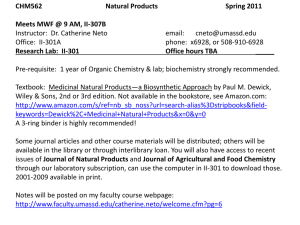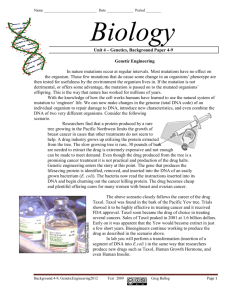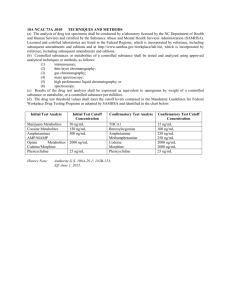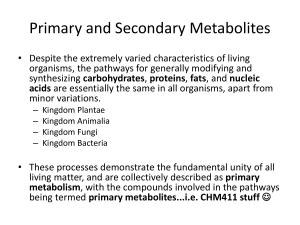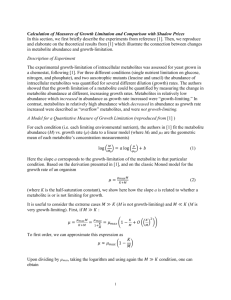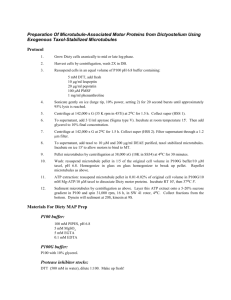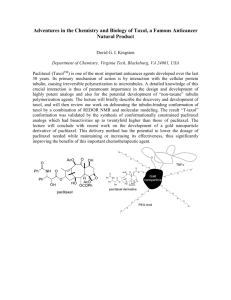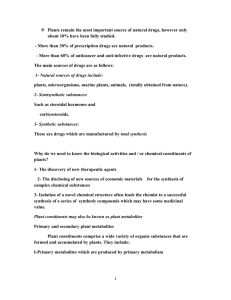PowerPoint Presentation - Valuable Chemical Production
advertisement
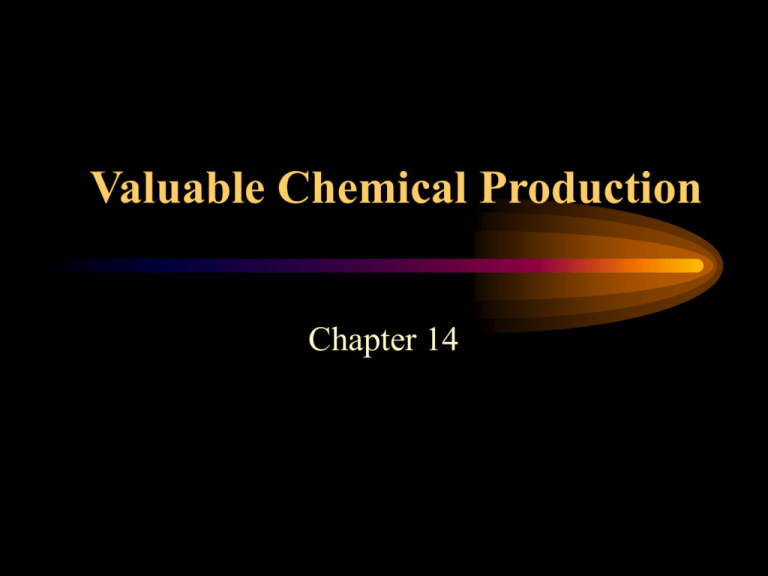
Valuable Chemical Production Chapter 14 1. Plants produce secondary metabolites • Primary metabolites run $1 to $2 per pound • Secondary metabolites run up to several hundred thousand dollars per pound Primary Metabolites • are substances that are widely distributed in nature, occurring virtually in all organisms. In higher plants these substances would be concentrated in seeds and vegetable storage organs. There are needed for general growth and development. Primary metabolites are low value-high bulk commodity items from plants (e.g. amino acids, starch, sugars, vegetable oils, etc.) Secondary Metabolites • are biosynthetically derived from primary metabolites. They are more limited in distribution being found usually in specific families. They are not necessary for growth and development, but may serve as pollination attractants, environmental adaptations, or protection. Kinds of Secondary Metabolites • alkaloids • phenolics (including polyphenols and tannins) • terpenoids 2. Establishing a plant cell culture for secondary metabolite production is a complex problem Not all cell types produce the desired metabolite • Within a specific cultivar of Catharanthus roseus, 62% of the clones produced the desired metabolite • whereas in another only 0.3% produced the metabolite Culture conditions must be optimized • e.g. concentrations of sugar, hormones, and vitamins • light • temperature Cell cultures can be grown on shakers or in fermentors Metabolite production is frequently higher in cell cultures • Berberine production from Coptis japonica is about 5% of dry weight after 5 years of root growth, which equals 0.17 mg/g per week. • Whereas in selected cell lines it can be 13.2% of the dry weight in cell culture after 3 weeks, which is about 44 mg/g/week or about 250 times higher 3. Metabolites can be produced in root cultures Many secondary metabolites are produced in roots • Scientists have developed a form of root culture using Agrobacterium rhizogenes, the cause of hairy root disease. (Show Fig 14.3) • Cells transformed with some of the bacteria’s DNA, causes the cells to be more sensitive to the hormones they produce. The cells form into roots. These roots grow very fast and produce the secondary metabolites that ordinary roots produce. Root cultures are often better than cell cultures • Roots often secrete the metabolites into the surrounding medium, making it easy for collection. • Charcoal can be added to the medium, the metabolites are absorbed by the charcoal, and this stimulates even higher production of the metabolite. Biochemical pathways of secondary metabolites can be quite long (sometimes up to 12 steps) • Precursors can be fed to either cell culture or roots to produce the metabolite in question. • In addition, cells can be genetically engineered to over-produce the metabolite, but this may be more difficult with pathways that have many enzymes. Some secondary metabolites produced in cell and root culture • L-DOPA: a precursor of catecholamines, an important neurotransmitter used in the treatment of Parkinson’s disease • Shikonin: used as an anti-bacterial and antiulcer agent • Anthraquinone: used for dyes and medicinal purposes • Opiate alkaloids: particularly codeine and morphine for medical purposes • Berberine: an alkaloid with medicinal uses for cholera and bacterial dysenterry • Valepotriates: used as a sedative • Ginsenosides: for medicinal purposes • Rosmarinic acid: for antiviral, suppression of endotoxin shock and other medicinal purposes • Quinine: for malaria • Cardenolides or Cardioactive glycosides: for treatment of heart disease Some goals are to eliminate secondary metabolites • Cannabinoids: to make hemp plants cannabinoid-free • Caffeine: to produce caffeine-free plants Taxol: an example • Taxol is a unique anticancer drug from the bark of the Pacific Yew (Taxus breviola) Pacific Yew Facts • Pacific Yew was considered a trash tree by foresters • The tree is slow growing, taking about 50 years to mature • It grows best in the understory of other trees, not doing well in direct sunlight Taxol Facts • Very effective treatment against ovarian cancer, breast cancer, melanoma, and colon cancer • Stops cell division, thus blocking cancer. It does this by interfering with microtubule function. Microtubules are responsible for pulling apart the sets of chromosomes in mitosis. Taxol Needs • It is estimated that 250 kg of pure Taxol are needed to treat cancer in the USA. This would require the bark of about 360,000 trees per year! • Obviously Taxol woud be very expensive by this method (approximately $200,000 to $300,000 per kg). Taxol is a very good target for biotechnology • • • • • a) tissue culture of bark cells b) fungus produces taxol c) alternative species d) genetic engineering e) chemical synthesis a) tissue culture of bark cells • Many cells from different bark tissues from different trees were screened. • There are at least 25 fold differences in production. It was found to be secreted into the medium thus facilitating collection. • So far 1 to 3 mg of taxol are produced per liter of cell culture. This is equivalent to about 25 g of bark. b) fungus produces taxol • It was found that a fungus that colonizes yew trees also produces taxol • Fungal culture technology which is better developed than plant cell culture technology could be an important source for taxol production c) alternative species • Some researchers found that the European Yew (Taxus baccata) produces a precursor to taxol. • This precursor can then be converted to an analog of taxol in the laboratory. • The precursor is used for chemical synthesis of taxol. d) genetic engineering • Other scientists are trying to identify and clone the genes which produce taxol • This will enable them to scale up production in cell culture e) Chemical synthesis • Until 1994, chemical synthesis was formidable • 3 different ways to synthesize taxol are now known • Some take up to 13 steps • Cost per patient still expensive; about $20,000 4. The economics of large-scale plant cell culture favor only a few products at the present time This is because it usually takes 10 years of research to produce a product. This requires that a product sell for at least $400 per kg to make it economically worthwhile. 5. Producing secondary metabolites in tissue culture may have a negative impact on the economics of the Third World countries • Many of these Third World countries may lose market share to superior, more efficient production of secondary metabolites in industrial countries. • Is this right? Is it fair? Are third world countries capable of competing? What should they do?

